
The following list presents the full set of National Register of Historic Places listings in Multnomah County, Oregon. However, please see separate articles for listings in each of Portland's six quadrants.

The Sovereign Hotel was a Portland, Oregon, hotel built in 1923. The nine-story building was added to the United States' National Register of Historic Places on December 2, 1981. Part of the building houses a portion of the Oregon Historical Society's Oregon History Center.

The Admiral Apartments, originally the Wheeldon Apartments and also known as the Admiral Hotel Apartments, is a five-story brick Tudor Revival apartment building in downtown Portland, Oregon, United States, that was built in 1909. It has been on the National Register of Historic Places since 1990.

The Broadway Hotel is a historic hotel building located in Portland, Oregon, built in 1913. As of 2009, it was managed as single room occupancy apartments under the name Helen M. Swindell Apartments. It is listed on the National Register of Historic Places. It was designed by Portland architect John Virginius Bennes's Bennes and Hendricks firm.

The Del Rey Apartments, located in northeast Portland, Oregon, are listed on the National Register of Historic Places.

The Irvington Bowman Apartments is an apartment complex located in northeast Portland, Oregon listed on the National Register of Historic Places.

The Lindquist Apartment House is an apartment complex located in northeast Portland, Oregon listed on the National Register of Historic Places.
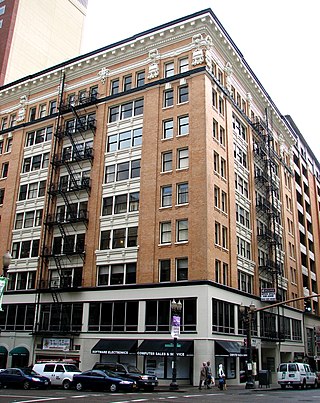
Carl L. Linde was an American architect based in the Pacific Northwest of the United States, particularly in Portland, Oregon. Several of his works are listed on the National Register of Historic Places.

The Alphabet Historic District, is a historic district in the Northwest District of Portland, Oregon which was listed on the National Register of Historic Places in 2000. It is 156.9 acres (63.5 ha) in area and includes 478 contributing buildings. It is roughly bounded by NW Lovejoy St., NW Marshall St., NW 17th Ave., W. Burnside St., and NW 24th Ave.
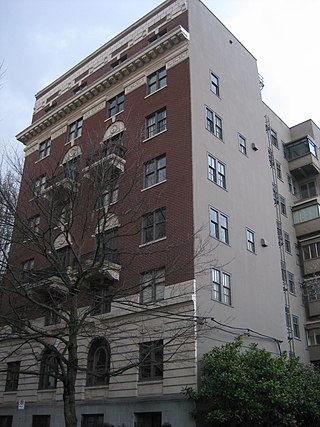
The 705 Davis Street Apartments is a historic residential building located at 2141 Northwest Davis Street in Portland, Oregon, in the United States. It was designed by Morris H. Whitehouse and J. André Fouilhoux via the firm Whitehouse & Fouilhoux, and was completed in 1913. It quickly became one of Portland's most fashionable addresses due to its fine design and materials and large rooms. Its original owner, Julia Hoffman (1856–1934), was a major figure in the Portland arts community, both as practitioner and advocate. She lived in the building's penthouse until her death.

The Page and Son Apartments is a tenement building located in Portland, Oregon designed by prominent architect John Virginius Bennes. The structure is listed on the National Register for Historic Places.
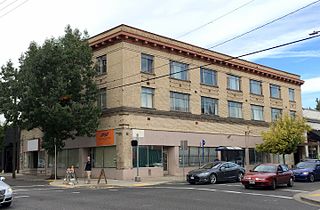
The Vivian Apartments, originally known as the Alco Apartments, are a historic, commercial/apartment building located in Portland, Oregon, United States. Built in 1912 at the northern end of Portland's eastside commercial core, the building typifies the mixed-use commercial development that occurred along Portland's streetcar lines in the eastside area during the early 20th century. It was noted for quality design and construction when it was built, and retains significant character-defining characteristics, including transom windows and recessed entries in the commercial spaces, original fenestration on the rear elevation, a prominent apartment entrance and lobby, and decorative cornice and masonry. The building's significance is strongly echoed in the 21st-century renaissance of mixed-use construction and streetcars in Portland, with a new-generation streetcar line on Martin Luther King Jr. Boulevard immediately opposite the west elevation.

The F. E. Bowman Apartments is a historic apartment building located in the Irvington neighborhood of Portland, Oregon, United States. Constructed in 1913, it is one of the oldest apartment buildings in Irvington, and the best preserved from its era. Through its Craftsman styling, builder Frederic E. Bowman gave attention to blending the building into the neighborhood of pre-existing single-family homes. It is one of several apartment buildings of similar scale and/or style that Bowman added to Portland's urban landscape through his career.

The Frederick Turner Fourplex is a historic apartment building located in Portland, Oregon, United States. Built in 1928 in the Tudor Revival style, it is an outstanding example of Portland architect Roscoe D. Hemenway's (1889–1959) work in period revival styles during the 1920s through the 1950s. Hemenway was well known for designing well-appointed single-family homes, and the Turner Fourplex is one of very few multi-unit residences he produced.
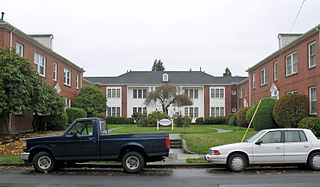
The Senate Court Apartments are a historic apartment building located in Portland, Oregon, United States. It is an important work in the career of Portland architect Roscoe Hemenway, who generally focused on single-family residential designs. In it, Hemenway employed the Colonial Revival style to draw out an air of respectability and tradition, in an effort to make apartment living more appealing to a middle-class clientele. Built in 1944 for developer Douglas W. Lowell, the complex was aimed at single women working in war industries. Lowell went on to develop over 3,000 housing units in Portland through his career.

The Thompson Court Apartments are a historic apartment building located in Portland, Oregon, United States. They represent an excellent example of architect Ewald T. Pape's steps toward making apartment living more appealing to the middle class. Built in 1929 for developer William K. Johnson, the building incorporates features such as two-story townhouse-type units, an L shape footprint to create greenspace, individual front and back entrances to each unit with individual addresses, and an overall emphasis on interior function over exterior design. While Pape was not unique in the use of these features, he stands out for utilizing all of them as a cohesive whole in his best buildings.
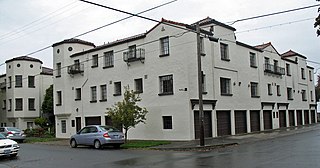
The Salerno Apartments are a historic apartment building in Portland, Oregon, United States. Built in 1929–1930 in the Mediterranean Revival style, its courtyard evokes "a quiet street in an old Mediterranean town". Architect Carl L. Linde experimented with garden court-type apartments in the nearby 1929 Sorrento Apartments, and perfected the form in the Salerno building.






















